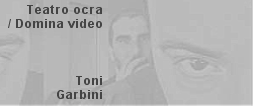
89 Seconds at Alcázar, 2004
cliquez ici pour le film / click here for the film
“Eve Sussman's 89 Seconds at Alcázar, 2004, is a High-Definition video tableau inspired by Diego Velázquez' famous painting Las Meninas, 1656, at the Museo del Prado. The video is an artistic revisioning of the moments leading up to and directly following the approximately eighty-nine seconds in time when the royal family and their courtiers would have come together in the exact configuration in Velázquez' painting.
To make 89 Seconds at Alcázar, the artist assembled a team of thirty-five which included an architect, set designer, choreographer, costume designer, actors, actresses and a film crew. While the actual shooting of the 360¡ video using a Steadicam was done in four days, the project took over three years to realize.
On the Inspiration for 89 Seconds at Alcázar
Originally called simply Portrait of the Royal Family, Las Meninas (or The Maids of Honor) is a seminal work in the history of art which has inspired countless artists. Its painter, Diego Velázquez, is one of the most important European artists of the seventeenth century, and Las Meninas is arguably his most famous work. At 10'5" x 9'5", the painting ?which hangs at the Prado Museum in Madrid?is grand in its composition and scale.
Las Meninas has been interpreted as "a candid representation of an actual event" and a highly structured composition with visual and intellectual subtleties. It is an extraordinary portrait of the royal family from 1656, which includes a self-portrait of their official painter. Diego Velázquez was court painter to Philip IV of Spain from 1623 until his death in 1660. His primary responsibility was to document the royal family. In recognition of his achievements, he was made a knight of the Order of Santiago in 1659.
In Las Meninas, Velázquez is shown on the left-hand side of the painting standing in front of a large canvas. He is painting a portrait of King Philip IV and Queen Mariana of Spain, whose images are reflected in the mirror on the back wall of the room. The Infanta Margarita and her companionsÑthe meninas or young ladies-in-waitingÑoccupy the center of the composition. Their attention is focused on the royal couple whose position, based on their reflection in the mirror, is the same as that of the spectator. With this technique, Velázquez effectively extended the space depicted on the canvas to include the real space the viewer occupies.
A staunch defender of his trade, Velázquez believed in the nobility of painting. He demonstrates this by placing himself in the picture, and giving us not only a portrait of the royal family, but a painting about the art of painting. It is the power of the piece as an artist's statement and as a snap shot of life at the Spanish court that motivated Eve Sussman to create 89 Seconds at Alcázar, a video installation of unprecedented beauty.
Annemarie Sawkins
Eve Sussman: Artist's Statement
My work originates from fascination with simple gestures and casual expressions, which I observe, capture, and stage in videos, films, installations, and photographs. Before making the move to High-Definition video in my last project, I often used Super-8 cameras and simple, low-tech surveillance devices to gain access to the situations and observe mundane relationships. I have referenced both scientific methods of long-term observation common in zoological and anthropological studies and the "cinema verité" tradition in filmmaking.
My piece, 89 Seconds at Alcázar (2004), is a carefully constructed video that takes Diego Velázquez' famous painting Las Meninas (1656) as a point of departure, treating it as the seminal cinema verité film still. The piece ultimately looks baroque but was inspired by the opposite - an interest in the everyday. Restaging the situation leading up to the moment depicted in the painting, 89 Seconds presents an imagined unfolding of minute movements that could have framed the scene. By linking the singular scene of the painting with a continuity of events I attempted to script and choreograph body language, instead of simply observing it in everyday life.
Over the past few years I have begun foraying into narrative, and became interested in how the seemingly untouched reality of cinema verité and the controlled operation of scripting and choreography overlap and collide. In my short film Solace (2001) I combined domestic documentary footage, shot during the days immediately following September 11, with staged video of the soprano Kati Agocs singing Henri Purcell's Music for Awhile to a group at a breakfast table who are oblivious to the singer's presence.
In the installation Ornithology (1997), I presented live-feed footage of pigeons in an airshaft behind the gallery where the work was shown. Wall-sized projections of pigeons observed from an extremely near vantage point both monumentalized animal and suggested a different economy of gestures. A bird watching tower in the airshaft was accessible to visitors via a ramp through the window. Once outside, the viewers became subjects under surveillance to be studied along with the birds in the video projections.
For How to Tell the Future from the Past, presented at the 1997 Istanbul Biennial, I wired the entire Serkeci train station with surveillance cameras and combined the live-feed video with narratives in Turkish and English. The synthesis of the live imagery with the stories created hybrid moments in which the action happening in the present became the illustrations for the recounting of the past.”
source infiniment fréquentable / highly recommended source: http://www.ubu.com/
traduction sur demande, ici
&
vidéo en Espagnol / video in Spanish:
& idem:
&
& aussi / also:
& surtout / overall:

Daniel Arasse, voir colonne de droite, see right handside column: créateurs d'inspirations, extrait / inspiring minds & works, extract
liens / links:
http://passouline.blog.lemonde.fr/2008/0...
http://www.e-litterature.net/publier2/spi...
http://lescontemporaines.fr/?L-analyse-de...
http://meticebeta.univ-montp3.fr/lexique/...
http://pagesperso-orange.fr/jean-paul.des...
...
* retour au début / return to the start *






















